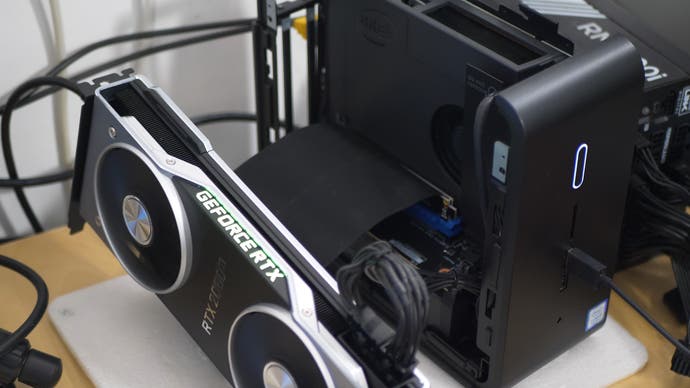Intel Ghost Canyon NUC: CPU gaming performance
Ashes of the Singularity, Crysis 3, Far Cry 5.
Getting a handle on CPU performance with the Ghost Canyon NUC was a key priority for this review simply because replacing the Core i9 9980HK effectively means swapping out the NUC compute element for a brand new one, which is likely to be a rather expensive proposition. There's the scope for extracting more performance from the existing processor by swapping in higher bandwidth memory (assuming the chipset can handle it) but really, we would expect to see the next big leap come from mobile versions of Intel's upcoming 10nm chips, which we expect to see ship in the next year or two. In looking at the results here, it's worth pointing out that the review unit NUC we were supplied with ships with 3200MHz DDR4, while our typical CPU benching uses 3600MHz low latency memory. So you can expect the desktop chips to benefit a little there over and above their power budget and frequency advantages.
Our primary methodology for testing CPU performance is to run at 1080p resolution using an RTX 2080 Ti, while our typical reviews also include 1440p and 2160p measurements for getting a grip on CPU differentials on more balanced systems. We're restricting ourselves to 1080p performance here, but in equalising parts with our desktop test subjects, we had to improvise a little. The NUC ships with a miniature RTX 2070, which isn't as powerful as the RTX 2080 Ti. To ensure consistency in results, we used a PCIe riser cable to the 2080 Ti, powering it using the NUC's 500W PSU - and yes, the little unit worked just fine here as two eight-pin PCIe power inputs are offered (even though just one of them is used on the Asus card).
We have three data points here for getting a handle on NUC performance. Ashes of the Singularity's CPU stress test under DX12 stresses all cores and all threads and has the biggest hit to processor clocks (it's about 3.8GHz to 3.9GHz on the NUC's 9980HK). The benchmark runs through a series of intense RTS gameplay with thousands of units. Battle plays out exactly as they would in-game with one exception: the units are indestructible, heightening CPU load. You can see the differentials yourself below by hovering over each bar and clicking on the table to swap between frame-rates and the arguably more meaningful percentage differentials.

This first benchmark suggests that the Core i9 9980HK in the NUC delivers around 80 per cent of the performance of the desktop 9900K, running equivalently to the Ryzen 5 3600X. It's not a bad result, but it appears that the presentation here is running with some kind of weird v-sync variant active, which may be lowering the result. Even so, it's still a decent performer, but the fact it's stressing every core all of the time is perhaps not indicative of real-life gaming performance in most titles, where the GPU would be the primary limiting factor to PC performance.
That's where Crysis 3 comes in. It'll utilise all cores and threads, but not in equal measure. This gives the i9 9980HK a chance to operate at higher clocks and it's here where we start to see the mobile processor close the gap with desktop equivalents. The results are impressive. Across the bench, the 9980HK matches the Ryzen 7 3700X and Ryzen 5 3600X (which deliver much the same performance) and it offers 91 per cent of the frame-rates delivered by the top-ranked Core i9 9900K. This is a truly impressive showing for a mobile processor - and remember that it is using slower memory than all of the desktop parts tested here.
Far Cry 5 is the final CPU here and again, it's chosen for a reason. The Dunia engine provides more consistent performance with additional threads (as witnessed when looking at lowest one per cent scores), but its average frame-rate results are very much driven by single core performance, in common with a lot of game engines - usually older ones, to be fair. In this kind of workload, the insane frequencies delivered by the i9 9900K and i7 9700K deliver a lot of extra throughput. The NUC delivers around 84 per cent of the 9900K's output - but even so, it's still a good chunk faster than desktop Ryzen processors.
Ashes of the Singularity: CPU Test
Crysis 3: Very High, SMAA T2X
Far Cry 5: Ultra, TAA
Going into these tests, I was worried that gaming on the NUC may be compromised unduly by the use of a mobile part but it quickly becomes clear that the kinds of multi-core loads exerted by game engines is indeed very different to the stresses incurred by highly intensive tasks like video encoding. Even with an RTX 2080 Ti at 1080p - which effectively means we're CPU-limited at all times - the NUC runs with impressive core clocks and once again, there's no sign of hitting thermal limits. Of course, you are paying a serious price premium for the compute element and its innovative form factor and there are obvious drawbacks over a standard desktop PC - but let's remember that all of the results here are derived from a five litre PC stacked up against full power desktop hardware.
With CPU performance quantified, it's time to move on to testing the Ghost Canyon NUC's graphics output via its bespoke miniature Asus RTX 2070. Specs for this card should suggest that the unit should operate just like any other kind of RTX 2070-powered PC, provided it's not CPU limited. However, our results throw up some interesting surprises...
Intel Ghost Canyon NUC analysis:








